Abstract
A xanthine biosensor was prepared by electrochemical immobilization of xanthine oxidize enzyme onto carbon paste electrode via entrapment of Bi3+. After the optimization of experimental parameters, analytical characteristics were investigated. Two linear ranges between 0.02 and 0.06 and 1–7.5 μM with the equation y = 93.00x + 0.12 and y = 1.07x + 18.03 with the correlation coefficients of R 2 = 0.9951 and R 2 = 0.9931, respectively, were obtained for this biosensing system. RSD value was calculated for 0.04 μM xanthine (n = 5) and found as 3.84%. LOD and LOQ values were also calculated and revealed as 1.30 × 10−8 and 4.3 × 10−8 M, respectively. Then, this biosensor was applied for xanthine detection in real samples. As a sample treatment, only necessary dilutions were made. Four types of beverages including wine, energy drink, peach, and sour cherry juice were used for this purpose. Obtained recovery values demonstrate that this system is applicable for xanthine detection in real samples without needing any laborious sample pretreatment procedures.




Similar content being viewed by others
References
Agüi L, Manso J, Yanez-Sedeno P, Pingarron JM (2006) Amperometric biosensor for hypoxanthine based on immobilized xanthine oxidase on nanocrystal gold–carbon paste electrodes. Sensors Actuator B 113:272–280
Anik Ü, Çevik S (2011) Centri-voltammetry for biosensing systems: biocentri-voltammetric xanthine detection. Microchim Acta 174:207–212
Anık Ü, Çevik S (2009) Double-walled carbon nanotube based carbon paste electrode as xanthine biosensor. Microchimica Acta 166:209–213
Anık Ü, Çubukçu M (2008) Examination of the electroanalytic performance of carbon nanotube (CNT) modified carbon paste electrodes as xanthine biosensor transducers. Turk J Chem 32:711–719
Anık Ü, Timur S, Çubukçu M, Merkoçi A (2008) The usage of a bismuth film electrode as transducer in glucose biosensing. Microchimica Acta 160:269–273
Anık Ü, Çubukçu M, Çevik S, Timur S (2010) Usage of bismuth film electrode as biosensor transducer for alkaline phosphatase assay. Electroanalysis 22:1519–1523
Anık-Kırgöz Ü, Timur S, Wang J, Telefoncu A (2004) Xanthine oxidase modified glassy carbon paste electrode. Electrochem Commun 6:913–916
Anık-Kırgöz Ü, Marin S, Pumera M, Merkoçi A, Alegret S (2005) Stripping voltammetry with bismuth modified graphite-epoxy composite electrodes. Electroanalysis 17:881–886
Bučková M, Gründler P, Flechsig G-U (2005) Adsorptive stripping voltammetric detection of daunomycin at a bismuth bulk electrode. Electroanalysis 17:440–444
Castaňeda MT, Pérez B, Pumera M, del Valle M, Merkoçi A, Alegret S (2005) Sensitive stripping voltammetry of heavy metals by using a composite sensor based on a built-in bismuth precursor. Analyst 130:971–976
Charalambous A, Economou A (2005) A study on the utility of bismuth-film electrodes for the determination of In(III) in the presence of Pb(II) and Cd(II) by square wave anodic stripping voltammetry. Anal Chim Acta 547:53–58
Çubukçu M, Timur S, Anik Ü (2007) Examination of performance of glassy carbon paste electrode modified with gold nanoparticle and xanthine oxidase for xanthine and hypoxanthine detection. Talanta 74:434–439
Demetriades D, Economou A, Voulgaropoulos A (2004) A study of pencil-lead bismuth-film electrodes for the determination of trace metals by anodic stripping voltammetry. Anal Chim Acta 519:167–172
Hocĕvar SB, Wang J, Deo RP, Ogorevc B (2002) Potentiometric stripping analysis at bismuth-film electrode. Electroanalysis 14:112–115
Hu S, Liu C-C (1997) Development of a hypoxanthine biosensor based on immobilized xanthine oxidase chemically modified electrode. Electroanalysis 9:372–377
Hutton EA, Ogorevc B, Hocĕvar SB, Weldon F, Smyth MR, Wang J (2001) An introduction to bismuth film electrode for use in cathodic electrochemical detection. Electrochem Commun 3:707–711
Hutton EA, Hocĕvar SB, Ogorevc B (2005) Ex situ preparation of bismuth film microelectrode for use in electrochemical stripping microanalysis. Anal Chim Acta 537:285–292
Hutton EA, Ogorevc B, Hocĕvar SB, Smyth MR (2006) Bismuth film microelectrode for direct voltammetric measurement of trace cobalt and nickel in some simulated and real body fluid samples. Anal Chim Acta 557:57–63
Kefala G, Economou A, Voulgaropoulos A, Sofoniou M (2003) A study of bismuth-film electrodes for the detection of trace metals by anodic stripping voltammetry and their application to the determination of Pb and Zn in tapwater and human hair. Talanta 61:603–610
Kefala G, Economou A, Sofoniou M (2006) Determination of trace aluminium by adsorptive stripping voltammetry on a preplated bismuth-film electrode in the presence of cupferron. Talanta 68:1013–1019
Krŏlicka A, Pauliukaitĕ R, Švancara I, Metelka R, Bobrowski A, Norkus E, Kalcher K, Vytřas K (2002) Bismuth-film-plated carbon paste electrodes. Electrochem Commun 4:193–196
Legeai S, Vittori O (2006) A Cu/Nafion/Bi electrode for on-site monitoring of trace heavy metals in natural waters using anodic stripping voltammetry: an alternative to mercury-based electrodes. Anal Chim Acta 560:184–190
Merkoçi A, Anık-Kırgöz Ü, Alegret S (2007) Procedure 7: determination of lead and cadmium in tap water and soils by stripping analysis using mercury-free graphite–epoxy composite electrodes. In: Merkoçi A, Alegret S (eds) Comprehensive analytical chemistry. Elsevier, Amsterdam, pp 47–52
Merkoçi A, Anık Ü, Çevik S, Çubukçu M, Guix M (2010) Bismuth film combined with screen-printed electrode as biosensing platform for phenol detection. Electroanalysis 22:1429–1436
Timur S, Anık Ü (2007) α-Glucosidase based bismuth film electrode for inhibitor detection. Anal Chim Acta 598:143–146
Wang J, Lu J, Hocĕvar SB, Farias PAM, Ogorevc B (2000) Bismuth-coated carbon electrodes for anodic stripping voltammetry. Anal Chem 72:3218–3222
Wang J, Lu J, Anık-Kırgöz Ü, Hocĕvar SB, Ogorevc B (2001a) Insights into the anodic stripping voltammetric behavior of bismuth film electrodes. Anal Chim Acta 434:29–34
Wang J, Anık-Kırgöz Ü, Lu J (2001b) Stripping voltammetry with the electrode material acting as a ‘built-in’ internal standard. Electrochem Commun 3:703–706
Yang M, Zhang Z, Hu Z, Li J (2006) Differential pulse anodic stripping voltammetry detection of metallothionein at bismuth film electrodes. Talanta 69:1162–1165
Zhang J, Wang LP, Guo W, Peng XD, Li M, Yuan ZB (2011) Sensitive differential pulse voltammetry of caffeine in medicines and cola using a sensor based on a multi-walled carbon nanotubes and nafion. Int J Electrochem Sci 6:997–1006
Acknowledgments
We would like to thank Dr. Atilla Çoşkun and Dr. Ergün Taşarkuyu from the Muğla University Physics Department for their valuable help for AFM images.
Author information
Authors and Affiliations
Corresponding author
Rights and permissions
About this article
Cite this article
Anik, U., Çubukçu, M. Application of Bismuth(III)-Entrapped XO Biosensing System for Xanthine Determination in Beverages. Food Anal. Methods 5, 716–722 (2012). https://doi.org/10.1007/s12161-011-9304-3
Received:
Accepted:
Published:
Issue Date:
DOI: https://doi.org/10.1007/s12161-011-9304-3




